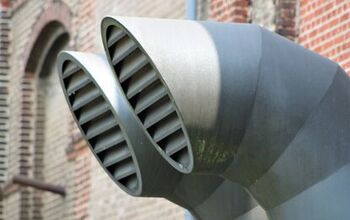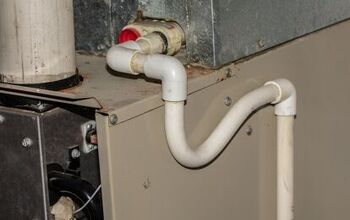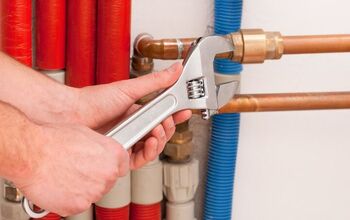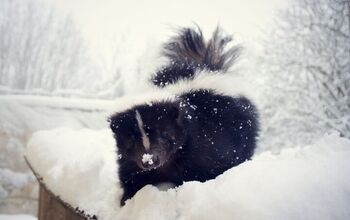Furnace Leaking Water In Winter? (Possible Causes & Fixes)

For those of us that live in colder climates, the furnace is arguably the most important feature of a home. When the temperatures drop into the single digits and below, staying comfortable and warm is of the utmost importance.
So, when you notice that your furnace is leaking water while running in the winter, it can be an alarming sight. Instead of freaking out, do some troubleshooting. The most common reasons that you are seeing water leak from your furnace in the winter are a leaky humidifier, problems with your air conditioner, or a defective vent pipe.
Do You Need Furnace or Heating System Repair?
Get free, zero-commitment quotes from pro contractors near you.

Why Is My Furnace Leaking Water in the Winter?
For most conventional furnaces, there is usually one of three reasons behind that water you see leaking out in the winter. Being able to recognize the problem is important for implementing a timely fix. The longer you let the issue go, the more potential damage can be done.
It is also important to know that leaks can be serious business. If left unchecked for long enough, water can do serious damage to walls, floors, and furniture. In the most extreme cases, it can even cause structural damage. Don’t ignore the issue; do something as soon as you see something.
Air Conditioning Problems
Even though it may seem obvious that the furnace is leaking as it runs in the winter, that might not be the case at all. What really may be happening is that there is an issue with your air conditioning unit instead.
A situation like this is more likely should the furnace be part of an HVAC system or if it is directly connected to your indoor air conditioning unit. While we know that the air conditioner cools, it is also meant to dehumidify the ambient air throughout your home.
The process of dehumidification is all about absorbing water out of the air. When it absorbs, all of that moisture drains out of the air conditioning unit through the condensate drain line. When that line gets clogged or starts to leak, you will notice water leaking out into the surrounding areas. That includes the furnace.
Humidifier is Leaking
Now that we know a little more about the dehumidification process, it may surprise you to know that some furnaces also have a built-in air handler with a humidifier. Those humidifiers make sure that the air that circulates back into your house is not overly dry.
Unlike a dehumidifier, which removes moisture from the air, a humidifier adds it back into the air. In dryer climates, humidifiers are commonly used. You may even notice that there is a humidifier mechanism on the outside of your furnace.
Clogs and leaks. When the humidifier within the furnace gets clogged up or springs a leak, then water can begin leaking and dripping into the furnace itself. Given enough time, it will begin to pool around the humidifier, creating that scary-looking leak.
Bad Vent Pipe Design
Conventional furnaces don’t extract heat from any of the exhaust gases that it produces. Those gases get expelled the instant they are produced. That means there is not enough time for the condensation to cool in the flue pipe (which can also be known as a vent pipe).
Poor design. The only instance where that condensation will take place is if the vent is either poorly designed or poorly installed. You would see this if the flue pipe is excessively long, has a slope, is too big, or is even clogged.
When this is the case, those exhaust gases get trapped in the pipe long enough to produce condensation. That condensation then drips back into the furnace, creating the leaking that you see.
How to Troubleshoot a Leaking Furnace
While the simplest explanation is always to call in a professional, that can be costly. After all, most services will charge a minimum fee and, if the issue is comprehensive, it could take several hours to get the job done.
Thankfully, there are a few helpful tips that can get you effectively troubleshooting the issue in no time flat.
- Check the vent pipe. Take a look at the structure, shape, and integrity of the vent pipe. If it seems off, then you can safely assume that this is the issue. A professional should probably do the job, but at least you can save them the time of troubleshooting.
- Check the humidifier. Look for any blockages or leaks coming from the drain line, feed tube, or any of the external casings. Any noticeable damage is a good indication that one of the components will need to be replaced.
- Check the air conditioner. When the air conditioner is leaking, it is important to contact a local HVAC professional to do the job. Air conditioner leaks can be comprehensive and there are too many things that can go wrong. Leave it in the hands of a pro.
What if There is Water Dripping from the Vent Pipe?
In condensing furnaces, condensation is totally normal (condensation is in the name, after all). So, if you see a little bit of condensation around the furnace, that is totally normal. To make the water go away, some small tweaks are needed.
Should you notice a full-on leak, then you have a problem. It could be one of four things: a bad heat exchanger, a blocked condensation drain, line issues, or problems with the condensation pump.
- Heat exchanger. The exchangers in condensing furnaces are meant to extract any extra heat as the furnace produces exhaust fumes. The vapors within those fumes get condensed into water during the extraction. Water then gets channeled out. If the heat exchanger has a crack or goes bad, it can result in more condensation that is normal.
- Broken drainage component. The condensation drain, line, and pump all play important parts in removing that excess condensation. When there is an issue in one of those components, the water can accumulate and even leak. The most likely cause is a clog or a break somewhere in the drainage system.
- Bad air conditioning unit. Condensing furnaces are much the same as conventional ones in that there could be water coming from a bad air conditioning unit. Do your homework and troubleshoot the issue to find the source of the leak. That should tell you more than enough about the problem at hand.
How to Troubleshoot a Leaking Condensing Furnace
Despite the fact that condensing furnaces have regular condensation present, an actual leak is another story entirely. Troubleshooting the issue can provide you with the opportunity for a quick repair or can at least help the HVAC technician identify the problem sooner.
- Drain trap. Start out by looking at the drain trap. More often than not, this component can get clogged up by dust and dirt. Clean it out thoroughly; a shop vac is probably the best bet for this task.
- Drain pump/lines. When the drain trap is clean and functioning normally, the next step is to examine the drain lines and condensation pump. Any clogging, cracking, breakage, or signs of malfunction means that component will either need to be cleaned or replaced.
- Heat exchanges. Finally, check on the heat exchangers. They can sometimes become caked with dust and debris; a quick cleaning can get them going again. Should you notice any damage or cracking in the heat exchanger, it will need to be replaced. It is probably best to let an HVAC technician do the replacement as the job can be tricky.
Is a Leaking Furnace Dangerous?
While it may not be a risk to your immediate safety, a leak in your furnace is not something to ignore. It could be indicative of a larger problem or cause water damage to the surrounding areas of your home, leading to further repair needs.
If you feel unsafe or worried, shut down the furnace and call your local HVAC technician. Under no circumstances should you ignore the leak. Under most homeowners’ insurance policies, you aren’t likely to be covered in the event of water damage from a furnace. It is seen as a lack of maintenance and you could be stuck paying the repair bill out of pocket.
Do You Need Furnace or Heating System Repair?
Get free, zero-commitment quotes from pro contractors near you.

Related Questions
How Many Years Should a Furnace Last?
With any appliance or fixture in a home, the key to longevity is proper maintenance and cleaning. Though it may seem like a hassle to perform these tasks, it will help keep the various components working properly.With the aforementioned maintenance and care, a furnace should last in the 15-20 year range. It depends on where you live and what type of furnace that you buy, too. Having scheduled maintenance each year is a good idea as an HVAC technician can perform a thorough cleaning and check to make sure all of the components are working properly.One thing that you can do that is quite simple and will help your furnace is to change the filter. Clogged filters are the culprit for many a problem and can be easily avoided. It is recommended that the filter get changed out once a month, every two at most.

Ryan Womeldorf has more than a decade of experience writing. He loves to blog about construction, plumbing, and other home topics. Ryan also loves hockey and a lifelong Buffalo sports fan.
More by Ryan Womeldorf



























